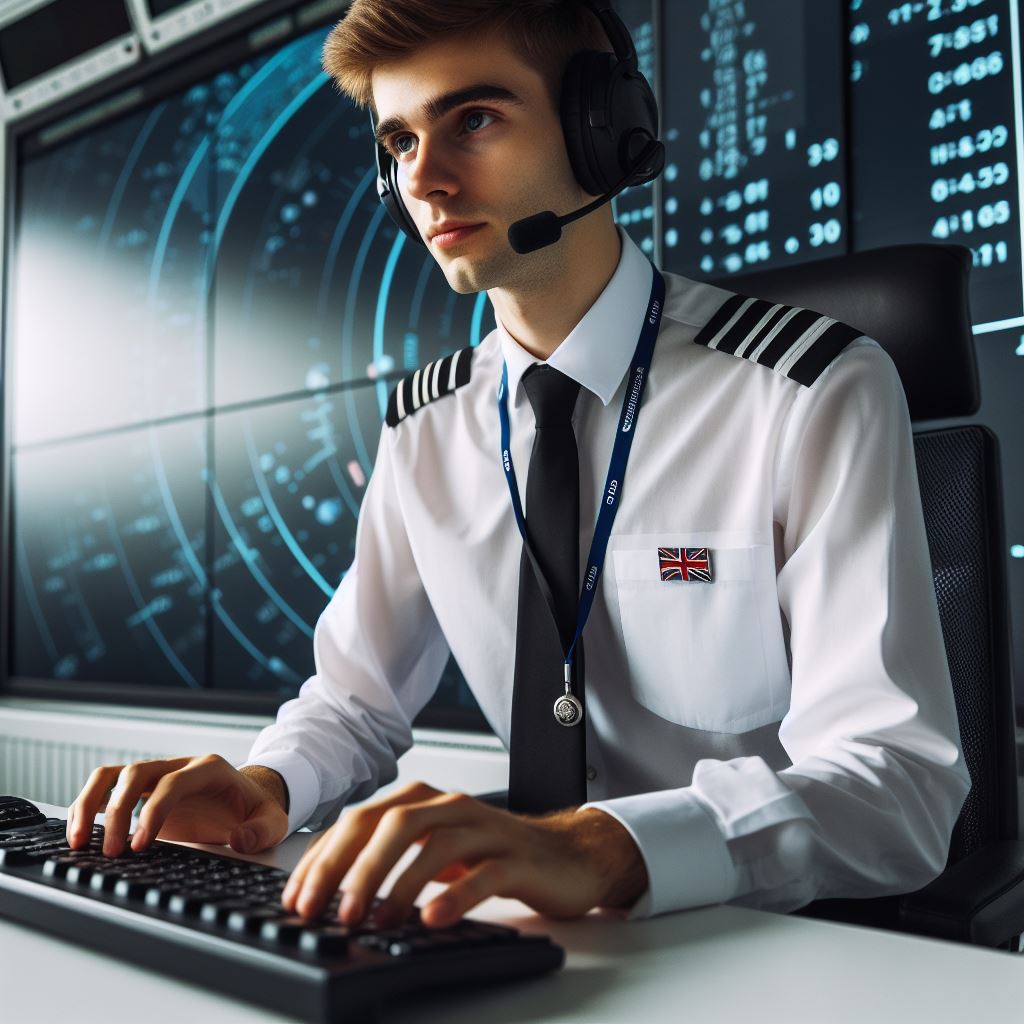Introduction
Air traffic control plays a vital role in ensuring the safety and efficiency of air travel.
It involves the management and monitoring of aircraft movements and communication between pilots and controllers.
In the United Kingdom, the current air traffic control system is operated by NATS (National Air Traffic Service).
Embarking on a journey into the unknown, this exploration delves into the intricate tapestry of “The Future of Air Traffic Control in the UK.”
As aviation evolves with cutting-edge technology and emerging challenges, this investigation unravels the potential transformations and innovations that lie ahead, shaping the skies and the role of air traffic control in the United Kingdom.
Join us as we navigate the horizon of possibilities and envision a future where safety, efficiency, and technological advancements converge in the dynamic realm of air traffic management.
Current air traffic control system in the UK
Overview of the current system and its key components (e.g., control towers, radar systems)
Currently, the air traffic control system in the UK comprises various key components.
Control towers play a crucial role in overseeing the movement of aircraft within their designated airspace.
They are equipped with radar systems that provide real-time information about the position and flight paths of airplanes.
Introduction of NATS (National Air Traffic Services) as the main provider of air traffic control services in the UK
One of the key organizations involved in air traffic control services in the UK is NATS (National Air Traffic Services).
NATS is responsible for managing the safe and efficient flow of air traffic in the country’s airspace.
Air traffic controllers currently handle airspace management and traffic flow control
Currently, air traffic controllers handle airspace management and traffic flow control by utilizing advanced technology and strategic decision-making.
They monitor the movement of aircraft within their designated airspace, ensuring safe separation distances between planes and managing the flow of traffic to prevent congestion.
With the help of radar systems, air traffic controllers track the position and speed of each aircraft, providing precise instructions for takeoff, landing, and routing during the flight.
They communicate with pilots through radio transmissions, guiding them through the airspace while adhering to established air traffic control procedures.
Personalized UK Career Consulting
Receive tailored career guidance designed just for you. Get actionable steps and expert support to boost your career in 1-3 days. Take control of your career now.
Get StartedAir traffic controllers also collaborate with other controllers and agencies to ensure the smooth operation of the entire air traffic control system.
They coordinate with neighboring control towers to hand over aircraft between adjacent sectors, maintaining seamless communication during the transition.
Additionally, air traffic controllers work closely with meteorological services to gather and analyze weather data.
They receive regular updates on weather conditions, which enables them to make informed decisions regarding routing and potential diversions if necessary.
The current air traffic control system in the UK continually evolves to meet the increasing demands of air travel.
Technologies such as satellite-based navigation systems and automated data processing are being integrated to enhance efficiency and safety.
Moreover, initiatives are underway to modernize the communication systems and infrastructure used by air traffic controllers.
These improvements aim to streamline operations, minimize human error, and ensure a more seamless and resilient air traffic control network.
In fact, the current air traffic control system in the UK relies on control towers, radar systems, and the expertise of air traffic controllers.
NATS plays a significant role in providing air traffic control services, ensuring safe and efficient flight operations.
Through advanced technology and strategic decision-making, air traffic controllers manage airspace and traffic flow while collaborating with other agencies.
The ongoing advancements and modernization efforts aim to further enhance the future of air traffic control in the UK.
Read: Balancing Life: Train Driver Edition
Upcoming challenges and changes
Increasing demands on air traffic control due to the growth of air travel
Air travel has experienced significant growth in recent years, and this trend is expected to continue in the future.
Your Dream Job Starts with a Perfect CV
Get a tailored CV and cover letter that captures your unique strengths and stands out in your industry. Let us help you make an unforgettable first impression.
Get StartedIncreased passenger demand, along with the expansion of airlines and new routes, means that air traffic control systems must handle more flights than ever before.
This places a strain on existing infrastructure and requires innovative solutions to maintain safety and efficiency.
The growth in air travel also means an increase in air traffic congestion, particularly in busy airports and airspace.
Air traffic control must find ways to manage this congestion effectively, ensuring that flights can take off and land safely and on time.
Failure to address this issue could lead to delays, increased costs, and potential safety risks.
Introduction of new technologies (e.g., drones) and their impact on air traffic control
The rise of new technologies, such as drones, presents both opportunities and challenges for air traffic control.
Drones are increasingly being used for various purposes, including delivery services, aerial photography, and recreational flying.
However, their integration into airspace requires careful management to prevent collisions with manned aircraft.
Air traffic control must develop regulations and systems to ensure the safe integration of drones into existing air traffic.
This includes establishing dedicated flight corridors and implementing software that can detect and track drones in real-time.
Additionally, air traffic controllers may need specialized training to handle the unique challenges posed by drones.
Effects of climate change and the need to manage airspace more efficiently
Climate change is causing shifts in weather patterns, leading to increased turbulence and unpredictable conditions.
This poses challenges for air traffic control as it must adapt to these changes and ensure the safety of flights.
Efficient management of airspace becomes crucial in mitigating the effects of climate change.
Optimize Your LinkedIn for Success
Boost your LinkedIn profile with a professional bio, keyword-rich headline, and strategic recommendations that attract recruiters. Stand out from the crowd and get noticed.
Optimize NowTo manage airspace more effectively, air traffic control can implement dynamic routing that adjusts flight paths in real-time based on weather conditions.
This flexibility helps avoid turbulent areas and reduces fuel consumption, resulting in cost savings and lower carbon emissions.
Additionally, improved forecasting and communication systems allow pilots and air traffic controllers to make better-informed decisions regarding flight routes and altitudes.
Introduction of new concepts such as Remote Tower Services and Digital Air Traffic Control
Advancements in technology have paved the way for new concepts in air traffic control, such as Remote Tower Services (RTS) and Digital Air Traffic Control (ATC).
RTS allows air traffic controllers to oversee multiple airports from a centralized location. This eliminates the need for physical towers at each airport, reducing costs and improving efficiency.
Digital ATC utilizes advanced communication and automation technologies to enhance situational awareness and streamline operations.
This includes the use of data analytics, artificial intelligence, and real-time data sharing between pilots, air traffic controllers, and airports.
These innovations improve coordination and decision-making, resulting in a more efficient and resilient air traffic control system.
In essence, the future of air traffic control in the UK faces several challenges and changes.
The increasing demands of air travel, the introduction of new technologies, the effects of climate change, and the adoption of new concepts like RTS and digital ATC all require proactive strategies.
By embracing these changes and implementing innovative solutions, air traffic control can ensure the safe and efficient management of airspace in the years to come.
Read: Stress Management Tips for ATCs in the UK

Remote Tower Services
What Remote Tower Services (RTS) are and how they work
Remote Tower Services (RTS) are a groundbreaking technology that promises to transform the future of air traffic control in the United Kingdom.
By leveraging advanced cameras, sensors, and communication networks, RTS allows controllers to remotely monitor and manage multiple airports from a centralized location.
The benefits of RTS, including cost reduction and increased flexibility
The benefits of implementing RTS in the UK are manifold. Firstly, it offers significant cost reductions compared to traditional tower infrastructure.
With RTS, there is no need for constructing physical towers at every airport, saving substantial construction and maintenance expenses.
Moreover, RTS provides increased flexibility for air traffic control operations.
Controllers can seamlessly switch between airports without the need for physical movement, ensuring efficient management of airspaces
Successful implementation of RTS in some European countries
Several European countries have already successfully implemented RTS in their air traffic control systems.
For instance, Sweden was the first country to adopt this technology, introducing it at Örnsköldsvik Airport in 2015.
Since then, RTS has been implemented in several other regional airports in Europe, including Estonia, Germany, and Norway.
Potential challenges and considerations in implementing RTS in the UK
However, implementing RTS in the UK does come with its fair share of challenges and considerations.
One of the primary concerns is ensuring the reliability and resilience of the communication networks used to transmit data between the remote tower center and the airports.
Additionally, there are security concerns surrounding the safeguarding of RTS systems against potential cyber threats.
The UK would need to invest in robust cybersecurity measures to prevent unauthorized access and tampering of critical air traffic control systems.
Moreover, the transition from traditional tower infrastructure to RTS requires significant training and upskilling of air traffic controllers.
They must familiarize themselves with the new technology and its interface to effectively carry out their responsibilities remotely.
Another aspect to consider is the public perception and acceptance of RTS in the UK.
A comprehensive communication strategy would be necessary to address any concerns from stakeholders, including pilots, airport operators, and regulatory bodies, ensuring they understand the benefits and safety of this innovative technology.
In general, Remote Tower Services offer immense potential in revolutionizing air traffic control in the UK.
With its cost-saving advantages, increased flexibility, and successful implementation in other European countries, RTS can enhance the efficiency and effectiveness of air traffic control operations.
However, careful attention must be given to address challenges such as reliable communication networks, cybersecurity, training, and public perception to ensure the successful implementation and acceptance of RTS in the UK.
Read: Air Traffic Control: Myths vs. Reality in the UK
Find Out More: UK Logistics: Understanding Supply Chain
Digital Air Traffic Control (DATC)
What Digital Air Traffic Control (DATC) entails
Digital Air Traffic Control (DATC) is a modern technology that revolutionizes the way air traffic is managed and controlled.
It involves the use of digital systems and advanced automation techniques to enhance efficiency and safety in the airspace.
Advantages of DATC
- Increased Situational Awareness: DATC provides real-time data and precise information about aircraft positions, weather conditions, and other relevant factors. This enhances the overall situational awareness of air traffic controllers.
- Data Integration: DATC seamlessly integrates various data sources into a single platform, enabling controllers to access comprehensive information. This facilitates better decision-making and reduces the risk of errors.
- Enhanced Efficiency: With DATC, air traffic controllers can efficiently manage larger volumes of air traffic, resulting in increased capacity and reduced delays. This leads to more efficient flight operations.
- Improved Safety: DATC systems incorporate advanced safety features that help mitigate risks and prevent accidents. These systems provide early warnings and ensure proactive actions are taken to maintain a safe airspace environment.
- Better Communication: DATC allows for seamless communication between air traffic controllers, pilots, and other relevant stakeholders. This improves coordination and ensures clear and accurate exchange of information.
Ongoing Trials and Research
Several trials and research projects are currently underway to explore the potential of DATC technologies.
These initiatives aim to assess the feasibility, effectiveness, and compatibility of digital systems in air traffic control.
One such trial is the Single European Sky ATM Research (SESAR) program, which focuses on developing innovative solutions for air traffic management.
The SESAR program includes the development and validation of DATC technologies to enhance the overall performance of the airspace.
Additionally, the National Air Traffic Services (NATS) in the UK is actively involved in researching and testing DATC systems.
These trials involve working closely with industry partners and regulatory authorities to ensure the successful implementation of digital solutions in air traffic control operations.
Concerns and Considerations
Although DATC offers numerous advantages, its adoption in the UK comes with certain concerns and considerations that need to be addressed.
One major concern is the potential vulnerability of digital systems to cyber attacks.
It is crucial to develop robust cybersecurity measures to protect DATC systems from unauthorized access and potential disruptions.
Furthermore, the training and re-skilling of air traffic controllers to effectively operate DATC systems pose significant challenges.
Adequate training programs and resources must be provided to ensure a smooth transition and maximize the benefits of digital technologies.
Another consideration is the cost associated with implementing DATC systems.
Upgrading existing infrastructure and acquiring advanced technologies can incur substantial expenses.
Careful planning and assessment of cost-effectiveness are essential when considering the adoption of DATC.
In summary, Digital Air Traffic Control (DATC) holds great promise for the future of air traffic management in the UK.
It offers increased situational awareness, data integration, efficiency, safety, and communication.
Ongoing trials and research demonstrate the commitment to exploring the potential of DATC technologies.
However, concerns regarding cybersecurity, training, and cost must be carefully addressed to ensure a successful transition to DATC in the UK.
Read: How to Become a Train Driver in the UK
Conclusion
The role of air traffic control in the UK cannot be underestimated. It plays a crucial role in ensuring the safety and efficiency of air travel.
As the aviation industry continues to grow, new challenges and changes will arise in the field.
This calls for continuous innovation and adaptation in air traffic control to meet the future needs.
Looking ahead, Remote Tower Services and Digital Air Traffic Control have the potential to shape the future of air traffic control in the UK.
These technologies offer enhanced efficiency, improved safety, and reduced costs.
By embracing these advancements, the UK can stay at the forefront of air traffic management.
To navigate the evolving landscape and ensure a successful future, it is imperative for the UK’s air traffic control sector to prioritize continuous research and development.
By fostering a culture of innovation and embracing technological advancements, the field can effectively meet the challenges that lie ahead.
Furthermore, strong collaboration between industry stakeholders, regulators, and government bodies will be essential in driving positive change.
The future of air traffic control in the UK holds immense potential.
By embracing and adapting to new technologies and approaches, the sector can continue to ensure the highest levels of safety and efficiency in airspace management, ultimately benefiting the entire aviation industry and the millions of passengers who rely on it.
[E-Book for Sale]
500 Cutting-Edge Tech Startup Ideas for 2024 & 2025: Innovate, Create, Dominate
$19.99 • 500 Tech Startup Ideas • 62 pages
You will get inspired with 500 innovative tech startup ideas for 2024 and 2025, complete with concise descriptions to help you kickstart your entrepreneurial journey in AI, Blockchain, IoT, Fintech, and AR/VR.




